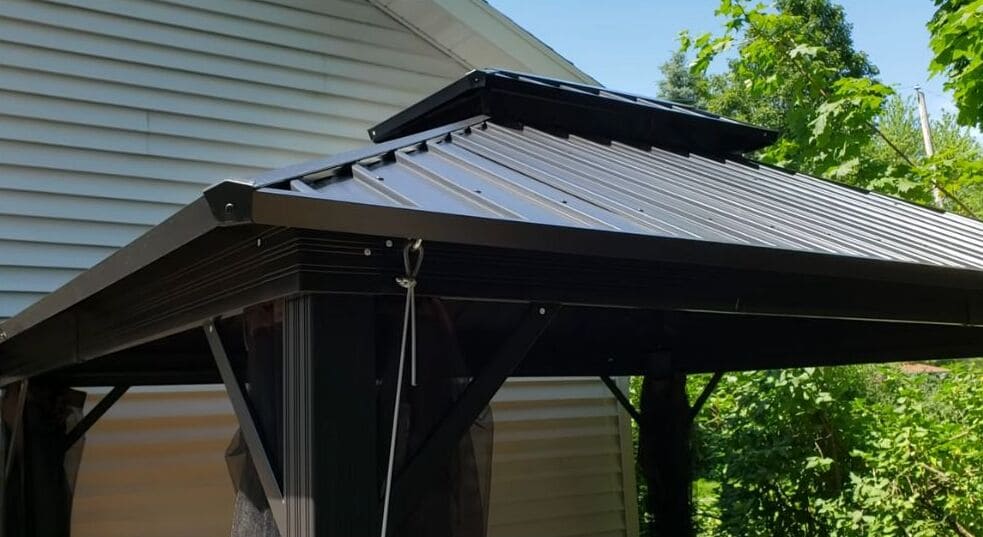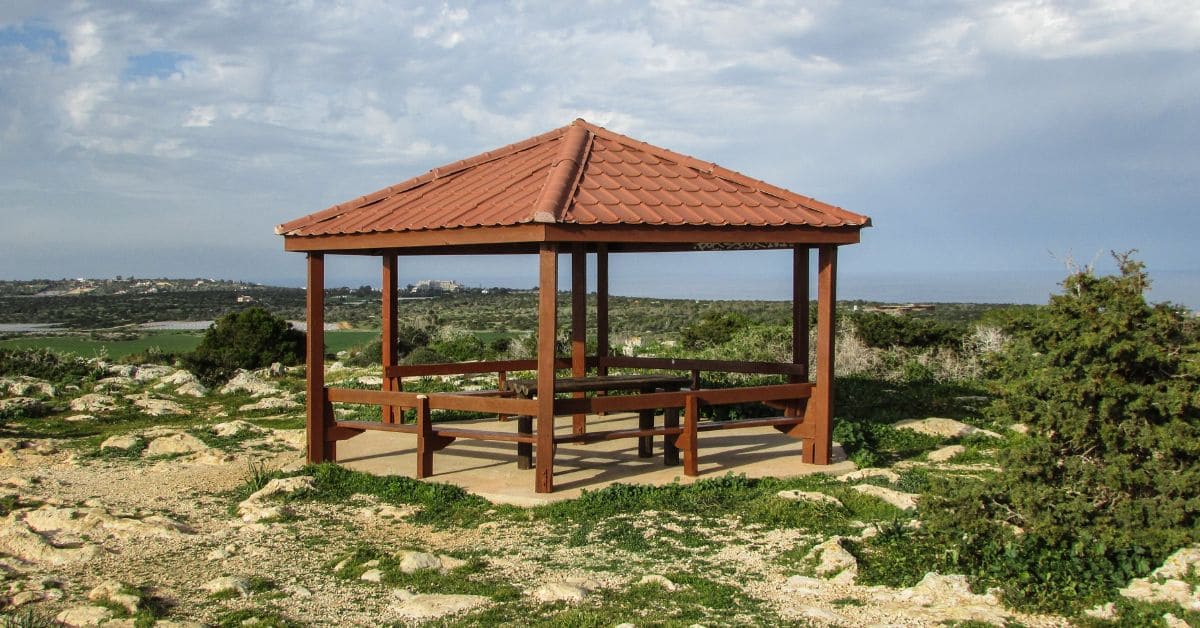When it comes to choosing between a wooden or metal gazebo, many people wonder which is more eco-friendly. Both materials have their pros and cons, and the decision ultimately depends on your priorities and preferences.
Wooden gazebos are often considered more eco-friendly because wood is a renewable resource that can be sustainably harvested. Additionally, wood has a lower carbon footprint than metal, as it requires less energy to produce.
However, wooden gazebos do require maintenance and may be more susceptible to rot and pests, which could lead to the need for a replacement sooner than a metal gazebo.
On the other hand, metal gazebos are durable, require little maintenance, and can often be recycled at the end of their lifespan. It’s important to weigh the environmental impact of both materials and consider the maintenance and longevity of each when making a decision.
Is wooden gazebo more eco-friendly than a metal: A metal gazebo is stronger and can be used in more ways than a wooden one. It’s also easier to put together and needs less upkeep. This stylish structure is great for parking your car under or as a place to relax and stay protected from the sun and rain.
Importance of Understanding the Environmental Impact of Gazebo Materials
Understanding the environmental impact of gazebo materials is crucial in making eco-friendly choices. Different materials have varying degrees of sustainability, and choosing the wrong one can lead to environmental harm.
By understanding the impact of the materials, you can make a more informed decision on what to use for your gazebo. This can help reduce your carbon footprint and promote a more sustainable lifestyle.
Additionally, using environmentally friendly materials can help preserve natural resources and protect the planet for future generations. Making conscious choices when it comes to gazebo materials can make a significant difference in creating a more sustainable world.
Is Wooden Gazebo More Eco-Friendly than a Metal: What’s the Difference?
People often choose metal or wooden gazebos as detached garages, but it can be challenging to decide which one to pick. Here are some factors to think about when choosing between an outdoor metal gazebo or a wooden gazebo.
The durability of a Gazebo:
Wooden gazebos can last a long time, but they can be easily affected by changes in the weather. If they are not well taken care of, the wood can move or break when exposed to extreme temperature changes. The wood may also become damaged, twisted, or even rot.
Metal gazebos that are used outside are very strong and long-lasting. They’re created using special types of aluminium and steel, which are coated with a powder that helps them resist bad weather, such as storms. Unlike wooden gazebos, metal ones don’t get damaged by sun or rain and they won’t become warped by temperature changes.
The best part is that they are not affected by rust, which means that anything you store inside them will stay safe even if it’s sunny, rainy, or snowy outside. Metal gazebos are also strong enough to resist insects, rust, and fire, which means that they’ll last a really long time.
Assembling the Structure:
When you buy a wooden gazebo kit, it will arrive as a pile of treated wood that needs to be put together smoothed out, and stained. Building this type of gazebo takes a lot of time and effort, which can be costly if you hire someone to do it for you.
On the other hand, assembling an aluminium gazebo is very easy. Whether you choose to build it yourself or have a professional do it, your metal gazebo can be assembled quickly.
Choosing the Gazebo Style:

If you want a traditional and cozy look, you might be interested in getting a rustic wooden gazebo. They’re typically made of special wood that’s been treated with chemicals to help them last longer. You can paint or stain it to match your backyard decor.
But if you prefer a modern and sleek look, an outdoor metal gazebo is perfect for you. They’re made of aluminium or steel and are ideal for a contemporary garden. These gazebos will add an elegant touch to your outdoor space and can also serve as a stylish garage.
Taking Care of Your Gazebo:
Taking care of a wooden gazebo can be a lot of work. The wood can get damaged by water, mold, or termites, so it needs to be taken care of every year. If you don’t do this, the gazebo may start to move or change its shape over time.
The wood can also look old and worn out within a few months. To maintain a wooden gazebo, you have to apply a new coat of stain or paint every year or two, and this can be expensive. You may even need to replace parts of the wood if they get damaged or cracked.
Metal gazebos, on the other hand, require very little maintenance. If they’re installed properly, you won’t need to worry about yearly upkeep, repainting, or fixing them.
These gazebos won’t get damaged by weather, and they’re not a good place for termites to live. They’ll also look new for a long time! To keep your metal gazebo clean, you can simply use a hose to get rid of dirt and dust or wash it with mild soap if needed.
Comparing the Costs of Metal and Wood Gazebos
Wooden gazebos are stunning, but they can be expensive to buy and maintain. You need to keep in mind that there are ongoing costs to keep them looking good.
However, outdoor metal gazebos offer beautiful style and luxury at a lower cost than most wooden gazebos. These metal gazebos look modern, last longer, and offer many possibilities, such as curtains and mosquito nets that are easy to install.
Our Superior Gazebo:
Consider buying a high-quality superior gazebo made of aluminium, steel, and polycarbonate for your outdoor space. These gazebos come in large sizes with luxurious features such as a double roof. They can give your gazebo a unique, custom look that stands out.
Selecting a Standard Gazebo:
Standard gazebos made of aluminum are a popular choice for those who want an affordable option. They come in different styles and have powder-coated aluminum frames and galvanized steel roofs for protection. These gazebos add a touch of elegance to your yard and can also be used as a detached garage.
A Premium Gazebo for Your Outdoor Living Space:
If you’re looking for the ultimate in style and durability, a premium gazebo is a way to go. These high-end structures are made with the best materials, such as polycarbonate and steel, which makes them very strong and long-lasting.
They’ll add a touch of elegance to your outdoor living space and provide a great place to relax and enjoy your yard for many years to come.
Making Sure Your Gazebo is the Right Size

When planning to install an outdoor metal gazebo, it’s important to choose the right size. Start by considering the size of your yard. A large gazebo can overwhelm a small yard, while a small gazebo might look odd in a large yard.
Also, think about what you plan to store in the gazebo. If it’s just for pool supplies or gardening equipment, a smaller gazebo should do. However, for vehicle or boat parking, you’ll need a larger gazebo that accommodates your vehicle’s size.
Creating a Gazebo Base:
If you’re considering an aluminium gazebo, you don’t need to worry about building a heavy foundation as they’re lightweight. You can attach them to your deck or patio safely, or anchor them in the yard using footers. However, you should plan how you’ll build the right base to ensure your gazebo is secure.
Factors to Consider When Choosing a Gazebo Material
When choosing a material for your gazebo, there are several factors to consider:
Budget and Cost-Effectiveness:
The cost of the gazebo is an important factor to consider. Wooden gazebos can be expensive, and they require ongoing maintenance and upkeep, which can add to the cost over time.
Metal gazebos, on the other hand, are generally more affordable and require less maintenance. Consider your budget and the long-term cost-effectiveness of the gazebo before making a decision.
Personal Preferences and Style:
Your personal preferences and style should also be taken into account when choosing a gazebo material. Wooden gazebos have a classic and traditional look, while metal gazebos offer a more modern and contemporary appearance. Think about the overall aesthetic of your outdoor space and choose a gazebo material that complements it.
Climate and Weather Conditions:
The climate and weather conditions in your area will impact the performance and longevity of your gazebo. Wooden gazebos can be susceptible to water damage, mold, and termite attacks, while metal gazebos are more resistant to these issues. If you live in an area with harsh weather conditions, consider a material that can withstand the elements.
Maintenance and Upkeep Requirements:
The maintenance and upkeep requirements of the gazebo material should also be taken into account. Wooden gazebos require annual staining or painting and may need occasional repairs or replacement of damaged wood.
Metal gazebos require little maintenance, but may need to be cleaned periodically. Consider the amount of time and effort you’re willing to put into maintaining your gazebo.
Long-Term Environmental Impact:

The long-term environmental impact of the gazebo material should also be considered. Wooden gazebos are made from a renewable resource but may contribute to deforestation if not sustainably sourced.
Metal gazebos are recyclable, but the production process may have a greater environmental impact. Consider the environmental impact of the material and choose a sustainable option if possible.
Tips for Sustainable Maintenance of Wooden and Metal Gazebos
Here are some tips for sustainable maintenance of wooden and metal gazebos:
Choose Eco-Friendly Materials:
When selecting a wooden gazebo, look for sustainably sourced and treated wood. For metal gazebos, choose materials that are made from recycled or recyclable metal.
Regular Cleaning:
Regularly clean your gazebo with a soft brush and mild soap to prevent dirt buildup and maintain its appearance. Avoid using harsh chemicals that can harm the environment.
Use Natural Products For Upkeep:
Use natural products like linseed oil, beeswax, or a water-based sealer for maintaining wooden gazebos. For metal gazebos, use a rust inhibitor to prevent corrosion.
Regular Maintenance:
Regularly inspect your gazebo for any signs of damage, rot, or rust. Repair any issues immediately to prevent further damage.
Reuse and Recycle:
Instead of disposing of old wooden or metal gazebos, consider repurposing them for other projects or donating them to someone else. Recycle any materials that cannot be reused.
Use Renewable Energy Sources:
When using power tools or lighting for maintenance, consider using renewable energy sources such as solar or wind power to reduce your carbon footprint.
By following these sustainable maintenance tips, you can help preserve your gazebo while minimizing your impact on the environment.
FAQs:
Q:1 Which is better, wood or metal gazebos?
A metal gazebo is stronger and more flexible than a wooden gazebo. It’s also simpler to put together and needs less upkeep. It’s a popular outdoor feature that can provide you with extra shade and shelter wherever you want it. You can even use it like a detached garage.
Q:2 Is an aluminium gazebo superior to a wooden one?
Aluminium is stronger than wood and won’t get damaged easily. It doesn’t get affected by fire or termites. Aluminium pergolas can last for many years without needing any repairs. However, they can get very hot in the sun.
Q:3 What is the ideal material to place a gazebo on?
Most gazebos use asphalt shingles as their roof material because it is a common and reliable option. You can choose shingle colours that match your home’s roof.
Rubber Slate is a cheaper and eco-friendly alternative to slate shingles that are easy to install. If you want an elegant and timeless look for your gazebo, you can use Cedar Shake shingles as a roofing material.
Q:4 Can the value of a home be increased by building a gazebo?
By making renovations, additions, and thoughtful design choices, you can quickly increase the value of your home. One of the ways you can achieve this is by adding a gazebo.
A gazebo makes your outdoor space special and creates more usable space outside, which can make your property more valuable.
Q:5 What is the best surface to have beneath a gazebo?
Concrete footings are great for outdoor areas that are uneven, or in places where building permits are needed. These footings can lift gazebos on one side and make them more stable on inclined surfaces. Even if the surface is flat, footings can still be used instead of a concrete slab.
Conclusion:
In conclusion, the choice between a wooden or metal gazebo in terms of environmental friendliness is not straightforward. Both options have their pros and cons, and the most eco-friendly option will depend on various factors such as the source of materials, manufacturing processes, and maintenance practices.
Wooden gazebos have the advantage of being a renewable resource and having a lower carbon footprint during manufacturing. However, they require regular maintenance and may not last as long as metal gazebos.
Metal gazebos, on the other hand, are more durable, require less maintenance, and can be made from recycled materials. Ultimately, the eco-friendliness of a gazebo will depend on various factors, and it’s crucial to weigh the environmental impact against other factors such as budget, aesthetics, and durability.
We hope you will be well aware of whether Is wooden gazebo more eco-friendly than a metal, one after reading this comprehensive article. If you have any questions or concerns, please don’t hesitate to feel free to comment below!

